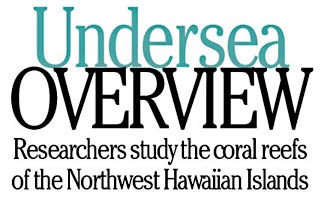— ADVERTISEMENT —


|
Scientists who just returned from a 34-day research mission to the Northwest Hawaiian Islands are already hoping to go back.
The maiden voyage of the 224-foot Hi'ialakai to survey nearly pristine coral reefs went "spectacularly well," said the ship's chief scientist, Randy Kosaki.
The Hi'ialakai, which means "embracing pathways to the sea" and "guiding leaders of the seas," traveled to the Northwest Hawaiian Islands Coral Reef Ecosystem Reserve to assess and monitor the health of the remote ecosystem. The National Oceanic and Atmospheric Administration ship, which was just commissioned Sept. 3, returned to Honolulu Saturday.
"It was the most amazing experience of my life," said Darla White, a fish rapid ecological assessment diver and graduate student of the University of Hawaii at Hilo. White made about 70 dives during the trip to count and measure fish and observed ulua, reef sharks and kahala.
During the five-week voyage, 18 researchers from various state and federal agencies and institutions monitored and mapped the islands. More than 800 dives were conducted in 30 days, said Kosaki. Data on fish, algae, coral and other invertebrates were collected.

|
The scientists are planning to make annual trips to the coral reserve.
About 70 percent of the coral reefs in the United States are found in the Northwestern Hawaiian Islands, which hosts more than 7,000 species including marine mammals, fishes, sea turtles, birds and invertebrates. A number of species are threatened and endangered, such as the Hawaiian monk seal.
Coral biologists are monitoring shallow coral back reef areas where significant bleaching is occurring, such as Pearl and Hermes Atoll, Midway and Kure. Coral bleaching, a term used to describe coral that is stark white in appearance, is triggered by warmer sea surface temperatures.
During this voyage, biologists discovered mild bleaching in shallow reef habitats at Pearl and Hermes as well as Maro Reef and Lisianski Island.
"It was a little disturbing," said coral rapid ecological assessment diver Jean Kenyon.
Kenyon said they hope to do follow-up surveys on the coral reefs next September when ocean temperatures at the Northwestern Hawaiian Islands reach their peak.
Biologists also found some coral species that had died and were overgrown with algae, while other coral species recovered well. The researchers also monitored the presence of tumors on table corals and observed more sightings of a disease called white syndrome, which causes tissue loss. Samples were collected to try and determine the cause of the disease.
Biologists aboard the Hi'ialakai also assisted divers from an NOAA charter research ship, Casitas, who discovered the remains of what are believed to be the whaling ships Pearl and Hermes that struck a reef in 1822.
— ADVERTISEMENTS —
— ADVERTISEMENTS —
